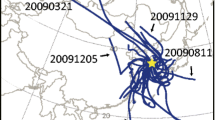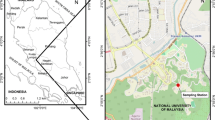Abstract
In this study, two rainfall events following the Antalya forest fires were sampled via a volume-based sequential sampling method. Two and four fractional samples were obtained from the first (S) and the second (M) rainfall events, respectively. pH and the conductivity of the fractional samples were measured at the end of the sampling. Fractional samples were analyzed for water-soluble ions. The water-insoluble particulate matter in the samples were analyzed for their particle size distributions using a particle size analyzer, and the morphologies of the particles were characterized using Scanning Electron Microscopy Energy Dispersive X-ray Spectroscopy (SEM–EDS). Concentrations of F−, Br−, NO2−, Cl−, NO3−, SO42−, PO43−, Ca2+, Na+, Mg2+, NH4+, K+, Li+ were determined by ion chromatography (IC). In the sequential rain samples, the average pH values were observed in the range of 5.37–6.35. 35 and no acid rain event was observed. In the particle size analysis results of rain samples, the highest measured value was 204.732 µm in S-series samples and 56.300 µm in M-series samples. Possible sources and/or source regions of the measured species were estimated using upper atmospheric back trajectory analyses and local wind roses. Markers of forest fires were determined as sulfate, chloride, calcium, ammonium, and potassium ions which were compared with the PM10 and PM2.5 forest fire emission source profiles reported in the US EPA SPECIATE database. In studies on the determination of air pollution transports; particles are collected on the filter and examined. This can cause many particles to accumulate on the filter and make it difficult to characterize. The use of a SEM device together with a particle size analyzer to characterize and detect particles in rainwater provides more successful results. The collected deposition event is more likely to obtain a single atmospheric particulate matter in samples than samples obtained directly from wet or dry deposition.







Similar content being viewed by others
Data Availability
Data availability is applicable to this article.
References
Dias CL, Oliveira MLS, Hower JC, Taffarel SR, Kautzmann RM, Silva LFO (2014) Nanominerals and ultrafine particles from coal fires from Santa Catarina, South Brazil. Inter J Coal Geo 122:50–60
Garcia KO, Teixeira EC, Agudelo-Castaneda DM, Braga M, Alabarse PG, Wiegand F, Kautzmann RM, Silva LFO (2014) Assessment of nitro-polycyclic aromatic hydrocarbons in PM1 near An area of heavy-duty traffic. J Aer Sci 479–480:57–65
Martinello K, Oliveira MLS, Molossi FA, Ramos CG, Teixeira EC, Kautzmann RM, Silva LFO (2014) Direct identification of hazardous elements in ultra-fine and nanominerals from coal fly ash produced during diesel co-firing. Sci Total Environ 470–471:444–452
Bayramoğlu-Karşı MB, Yenisoy-Karakaş S, Karakaş D (2018) Investigation of washout and rainout processes in sequential rain samples. Atmos Environ 190:53–64
Kılıç M, Pamukoğlu MY (2022) Determination of chemical compositions and morphologies of sequential rain samples in Antalya region. J Eng Sci Des 10(2):680–697
Keresztesi Á, Korodi A, Boga R, Petres S, Ghita G, Ilie M (2017) Chemical Characteristics of Wet Precipitation in The Eastern Carpathians. Romania Ecoterra 14:52–59
Seinfeld JH, Pandis SN (2016) Atmospheric Chemistry and Physics: From Air Pollution to Climate Change (3rd ed.) John Wiley & Sons.
WHO (2016) Report: ambient air pollution: a global assessment of exposure and burden of disease (Number: WA 754). World Health Organization, WHO Press, Geneva
Beeston M, Grgic I, van Elteren JT, Iskra I, Kapun G, Mocnik G (2012) Chemical and morphological characterization of aerosol particles at Mt. Krvavec, Slovenia, during the Eyjafjallajokull Icelandic volcanic eruption. Environ Sci Pollut Res Int 19:235–243
Dordevic D, Buha J, Stortini AM, Mihajlidi-Zelic A, Relic D, Barbante C, Gambaro A (2016) Mass distributions and morphological and chemical characterization of urban aerosols in the continental Balkan area (Belgrade). Environ Sci Pollut Res Int 23:851–859
Wang B, Harder TH, Kelly ST, Piens DS, China S, Kovarik L, Keiluweit M, Arey BW, Gilles MK, Laskin A (2016) Airborne soil organic particles generated by precipitation. Nat Geosci 9(6):433–437
Balasubramanian R, Victor T, Begum R (1999) Impact of biomass burning on rainwater acidity and composition in Singapore. J Geophys Res Atmos 104:26881–26890
Kulshrestha UC, Kulshrestha MJ, Sekar R, Sastry GSR, Vairamani M (2003) Chemical characteristics of rainwater at an urban site of South-Central India. Atmos Environ 37:3019–3026
Migliavacca D, Teixeira EC, Pires M, Fachel J (2004) Study of chemical elements in atmospheric precipitation in South Brazil. Atmos Environ 38:1641–1656
Migliavacca D, Teixeira EC, Wiegand F, Machado ACM, Sanchez J (2005) Atmospheric precipitation and chemical composition of an urban site, Guaiba hydrographic basin, Brazil. Atmos Environ 39:1829–1844
Mimura AMS, Almeida JM, Vaz FAS, de Oliveira MAL, Ferreira CCM, Silva JCJ (2016) Chemical composition monitoring of tropical rainwater during an atypical dry year. Atmos Res 169:391–399
Alonso-Blanco E, Calvo AI, Fraile R, Castro A (2012) The influence of wildfires on aerosol size distributions in rural areas. Sci World J 2012:1–13
Sun X, Wang Y, Li H, Yang X, Sun L, Wang X, Wang T, Wang W (2016) Organic acids in cloud water and rainwater at a mountain site in acid rain areas of South China. Environ Sci Pollut Res 23:9529–9539
Oduber F, Calvo AI, Blanco-Alegre C, Castro A, Célia Alves B, Cerqueir M, Lucarelli F, Nava S, Calzolai G, Martin-Villacorta J, Esteves V, Fraile R (2021) Towards a model for aerosol removal by rain scavenging: The role of physical-chemical characteristics of raindrops. Water Res 190:116758
Vicente A, Alves C, Calvo AI, Fernandes AP, Nunes T, Monteiro C, Almeida SM, Pio C (2013) Emission factors and detailed chemical composition of smoke particles from the 2010 wildfire season. Atmos Environ 71:295–303
Berberler E, Gemici BT, Ucun-Ozel H, Demir T, Karakas D (2022) Source identification of water-insoluble single particulate matters in rain sequences. Atmos Pollut Res 13:101499
Magnusson B (2014) in:Ornemark U.(eds.), Eurachem Guide: The Fitness for Purpose of Analytical Methods-A Laboratory Guide to Method Validation and Related Topics, Second ed.
Draxler RR, Hess GD (1998) An Overview of the HYSPLIT_4 modeling system of trajectories, dispersion, and deposition. Aust Meteorol Mag 47:295–308
Charlson RJ, Rodhe H (1982) Factors controlling the acidity of natural rainwater. Nature 295:683–685
Hu GP, Balasubramanian R, Wu CD (2003) Chemical characterization of rainwater at Singapore. Chemosphere 51:747–755
Lu X, Li LY, Li N, Yang G, Luo D, Chen J (2011) Chemical characteristics of spring rainwater of Xi’an City, NW China. Atmos Environ 45:5058–5063
Pu W, Quan W, Ma Z, Shi X, Zhao X, Zhang L, Wang Z, Wang W (2017) Long-term trend of chemical composition of atmospheric precipitation at a regional background station in Northern China. Sci Total Environ 580:1340–1350
Tiwari S, Hopke PK, Thimmaiah D, Dumka UC, Srivastava AK, Bisht DS, Rao PSP, Chate DM, Srivastava MK, Tripathi SN (2016) Nature and sources of ionic species in precipitation across the indo-gangetic plains, India. Aerosol Air Qual Res 16:943–957
Xing J, Song J, Yuan H, Li X, Li N, Duan L, Qu B, Wang Q, Kang X (2017) Chemical characteristics, deposition fluxes and source apportionment of precipitation components in the jiaozhou bay, North China. Atmos Re 190:10–20
Xu Z, Wu Y, Liu WJ, Liang CS, Ji J, Zhao T, Zhang X (2015) Chemical composition of rainwater and the acid neutralizing effect at beijing and chizhou city, China. Atmos Res 164:278–285
Goldberg ED (1963) The oceans as a chemical system. In: Hill, M.N. (Ed.), Sea 2, 158–175. Chapter, 1, Interscience, NY.
Bisht DS, Srivastava AK, Joshi H, Ram K, Singh N, Naja M, Srivastava MK, Tiwari S (2017) Chemical characterization of rainwater at a high-altitude site “Nainital” in the Central Himalayas, India. Environ Sci Pollut Res 24:3959–3969
Rao PSP, Tiwari S, Matwale JL, Pervez S, Tunved P, Safai PD, Srivastava AK, Bisht DS, Singh S, Hopke PK (2016) Sources of chemical species in rainwater during monsoon and non-monsoonal periods over two mega cities in India and dominant source region of secondary aerosols. Atmos Environ 146:90–99
Flues M, Hamma P, Lames MJL, Dantas ESK, Fornaro A (2002) Evaluation of the rainwater acidity of a rural region due to a coal-fired power plant in Brazil. Atmos Environ 36:2397–2404
Funding
The authors declare that no funds, grants, or other support were received during the preparation of this manuscript.
Author information
Authors and Affiliations
Contributions
Murat Kilic: Data curation, investigation, methodology, validation; Serpil Kilic: Corresponding Author, investigation, validation, visualization, supervision, writing-original draft, writing-review and editing.
Corresponding author
Ethics declarations
Conflict of interest
The authors have no relevant financial or non-financial interests to disclose.
Additional information
Publisher's Note
Springer Nature remains neutral with regard to jurisdictional claims in published maps and institutional affiliations.
Supplementary Information
Below is the link to the electronic supplementary material.
Rights and permissions
Springer Nature or its licensor (e.g. a society or other partner) holds exclusive rights to this article under a publishing agreement with the author(s) or other rightsholder(s); author self-archiving of the accepted manuscript version of this article is solely governed by the terms of such publishing agreement and applicable law.
About this article
Cite this article
Kilic, M., Kilic, S. Ionic Compositions of Sequential Rainfall Samples as Source Signatures of Forest Fire Emissions. Chromatographia 86, 153–165 (2023). https://doi.org/10.1007/s10337-023-04233-8
Received:
Revised:
Accepted:
Published:
Issue Date:
DOI: https://doi.org/10.1007/s10337-023-04233-8




